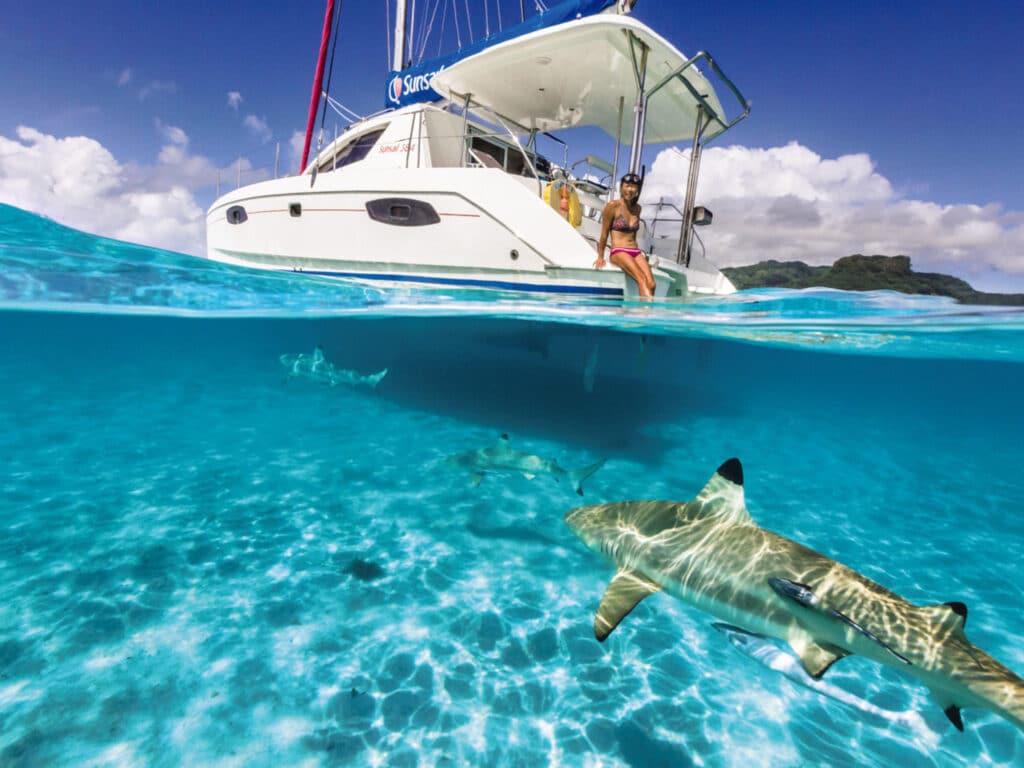
One summer evening many years back, a friend invited me to sail on a new Leopard 47 off Newport, Rhode Island. Although daylight was slowly fading, there was still a tug of a breeze when we met on the dock. After 11 years of cruising on my 60-year-old, gaff-rigged double-ender Tosca, just the ease of boarding the Leopard with a simple, normal step onto a stable platform—with no life-threatening leaps, stern-boarding cardio or ultra-athletic bowsprit avoidance—impressed me.
But as we slid out of the marina and hoisted the main, bluewater-voyaging PTSD washed over me, and I fought the need to madly stow charcuterie boards and wineglasses, my bags, their bags, pillows, plates, everything. When the captain suggested we set the jib, I braced myself in the cockpit, a reaction from years spent sailing with tight sheets on a steep heel. I still remember the sensation as we caught the first gust on the fast cat: We lifted over the water and took off, flying across the bay. Nothing on the tables slid. Nothing down below moved. No one was sprayed or flung across the cockpit. It was so quiet. The moon rose, the stars came out. More bottles of wine appeared. I was all-in.
That sunset sail decades ago brought me up to speed on what I’d been missing about cruising multihulls. My slow-but-much-beloved ketch provided full-contact sailing. I knew very little about multihulls, and the little I knew wasn’t helpful. I’d been cruising with friends on a wet Wharram cat in western Fiji and daysailing on a worn-down trimaran in Tonga. I’d seen the French cruisers zip by on their multihulls in Tahiti, but none of my Pacific friends in 1990s had anything close to the Leopard 47 I sailed that night.
None of my cruising friends had a million dollars either, so when asking if a multihull is right for you, let’s get right to it: Multihulls are expensive. The five new multihulls in CW’s 2023 Boat of the Year range in price from just under $1 million to just over $2 million. CW’s 2023 Best Cruising Multihull, the Fountaine Pajot Tanna 47, is listed at $825,000. And the pre-owned market is pretty competitive. The 23-year-old Leopard 47 model I sailed that night, after two decades of use, is listed for $350,000.
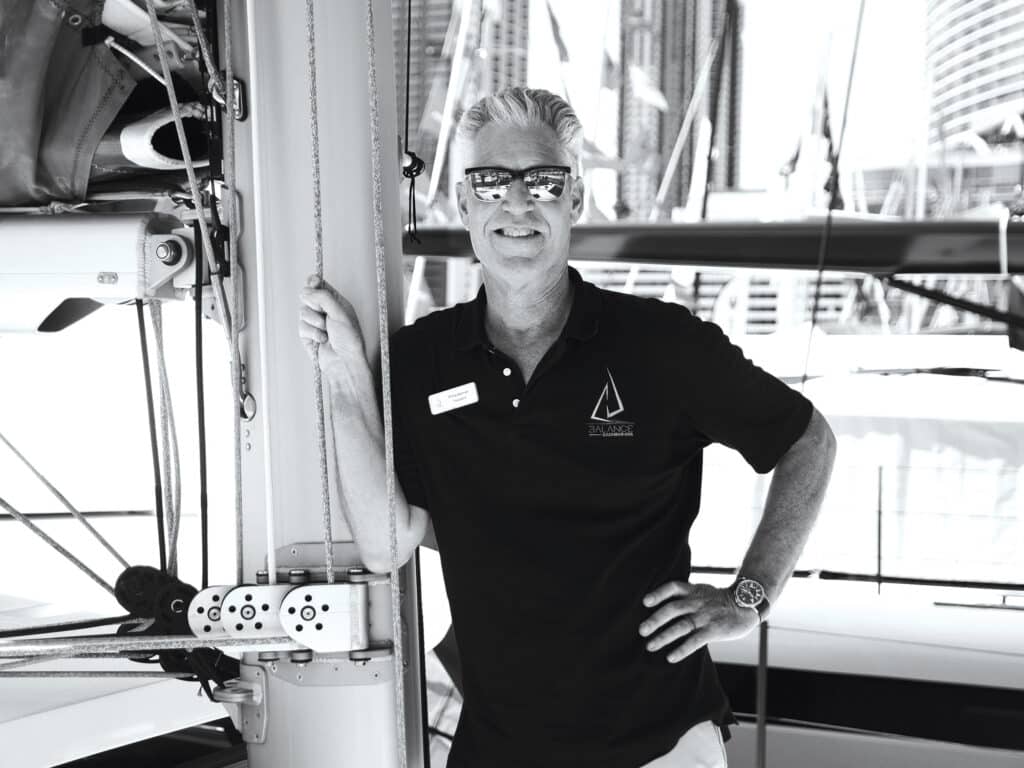
If there’s a silver lining here, it’s that multihulls hold their value. But the first step in determining whether a multihull is right for you is to talk to a builder or broker about your budget.
People, Plans and the South Pacific
If you’ve made peace with the buy-in and you’ve budgeted for the boat of your dreams, there are a lot of people with you. The 2022 State of the Sailing Industry Report numbers show that despite the cost, plenty of people are choosing the multihull path.
The most recent statistics show that 980 of the 4,937 new sailboats sold in the United States in 2021 were multihulls. That’s just shy of 20 percent. The multihulls break out as 654 domestic production and 326 imports. And multihulls make up 45 percent of the sailing charter fleet.
“The multihull movement started in earnest in the early 1990s, when The Moorings put catamarans such as Lagoon in the charter fleets, and Fountaine Pajot brought out the Venezia 42,” says Phil Berman, founder and president of Balance Catamarans. Berman founded The Multihull Company in 1999 and watched the steady growth of the multihull segment over the next several decades. The market struggled in 2008-10 with the financial crisis, but it exploded after that.
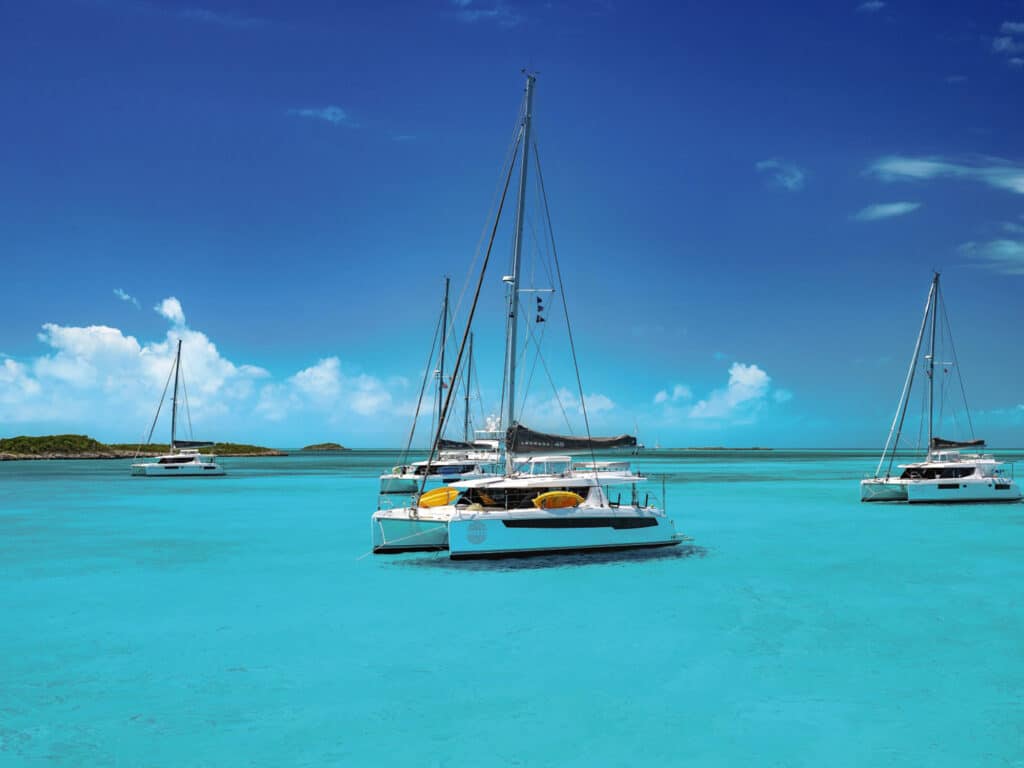
“Over the past 10 to 15 years, the market itself has matured quite a bit, with the retirement of the baby boomers,” he says. “The multihull market was growing steadily, but it really exploded during the pandemic. Balance Catamarans has grown from building two or three boats a year to 24 boats a year.”
And while The Moorings was the biggest player to popularize catamarans in the charter industry, Berman says, Hobie Alter did more than anyone for the catamaran industry as whole. Alter brought Hobie Cats to the public in the 1970s, and introduced fun, competitive sailing to young people outside of yacht clubs or any formal sail training. Many of those early Hobie Cat racers are owners in today’s cruising- and performance-multihull fleets.
What the Owners Say
“I grew up around monohulls and powerboats,” says circumnavigator Amy Alton. “My dad bought a Hobie Cat, and then a Maine Cat 30, where I had my first cruising experiences, and later, the one that my husband first sailed on.”
The boat she has today is a Fountaine Pajot Helia 44: “When we picked out our cruising boat, we were looking for good performance for downwind sailing and comfortable living space. Starry Horizons has been our home for eight years and is the boat we circumnavigated on.”
Performance, comfort and stability are the top reasons many cruisers choose multihulls. Faster offshore passages with downwind speed and overall higher cruising speeds are priorities. Mile for mile, multihulls are simply faster. Decades earlier, cruisers worried about how a multihull sailor might manage extreme weather conditions at sea. Advances in weather technologies such as Predict Wind have eliminated surprises during shorter passages, and the technological advancements in communication and route planning allow cruisers to track and avoid extreme weather during longer crossings.
This matters if you’re eyeing the Coconut Milk Run westward across the Pacific. There’s a lot of downwind miles, and a multihull will eat them up faster. In a blow, multihulls might be able to cover more miles faster, toward safety.
What about going to windward? Realistically, cruising multihulls can struggle; they typically sail close-hauled at 55 to 60 degree true wind angle. Performance catamarans can cut those angles a lot closer, sailing 45 to 50 TWA.
“Starry Horizons doesn’t point very well to the wind, but you know what? Neither do I,” Alton says. “We rarely rush our weather windows, so uncomfortable passages are few and far between.”
For cruisers looking to spend a season or two in the Bahamas or Caribbean, a multihull’s shallow draft and open, airy living quarters are a popular choice. With flights to the United States a short hop away, onboard space for guests is also ideal.
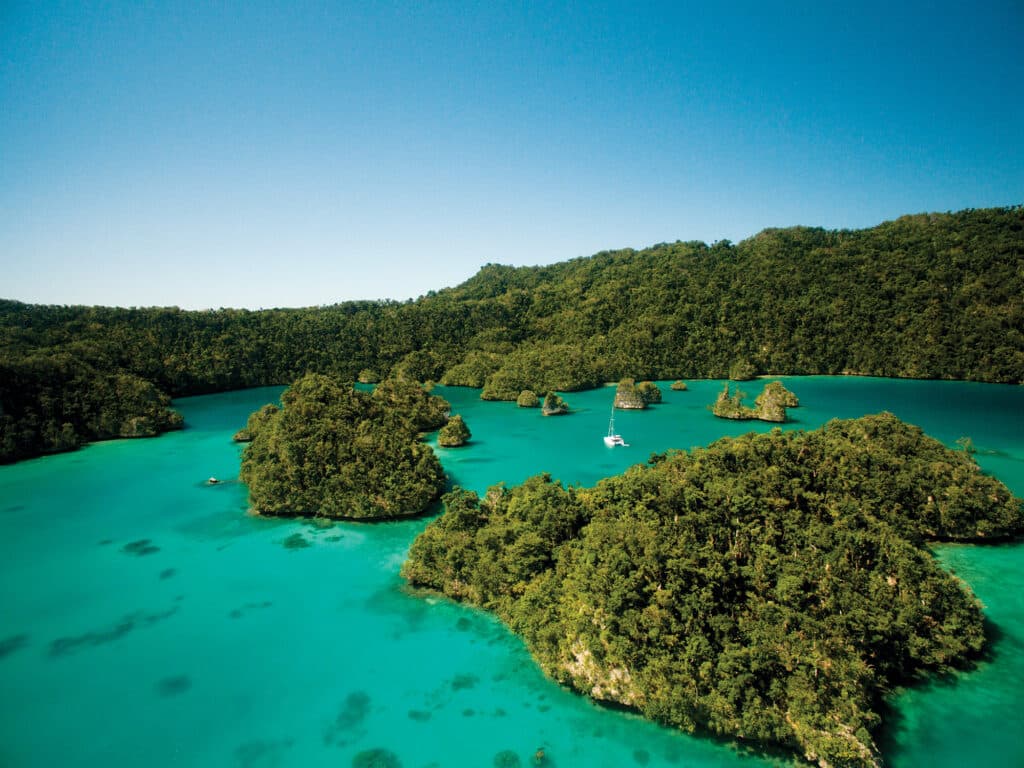
If you’re considering a multihull, where do you intend to spend most of your time? While the Caribbean trade winds and downwind sailing through the South Pacific make sense, the Roaring 40s might not. The French Riviera and the Italian Riviera simply might not have the space, and other destinations such as Spain and Scandinavia require research if you hope to secure a marina berth or schedule a haulout. In many places, end caps or slips with wide enough space for a cat’s beam might be close to twice the price, if you can find one open. Know before you go.
There’s also the need to adjust to handling such a beamy boat. I remember the joy of flying down Florida’s Caloosahatchee River in a 50-foot power cat over a Thanksgiving weekend, heading for a reserved spot at Sanibel Marina. But when we arrived at the dock with the light fading and the current and wind against us, I was relieved to see the dockmaster standing ready with a line. “It’s like parking a tennis court,” he said.
Dave Newman, a cruiser who sails the Balance 442 performance cat Umoya, says that the trade-offs he and his wife have made for the multihull life are worth it. He acknowledges that slips cost more and are harder to come by, but he usually anchors out. “More living, less camping,” Newman says. “Our boat’s comfortable on long passages and is a relatively flat sailing platform. The salon provides lots of light, great views, and headroom for taller people. We have redundant power with two engines, more coachroof space for solar panels, and a galley that is very pleasant to cook in.”
Although they need to manage weight sensitivity and clean two hulls instead of one, he’s happy with the design and sailing performance of his cat and, after a couple of years of cruising the Caribbean, hopes to head to the South Pacific.
“Don’t wait too long to buy a boat,” he says. “Buy what you can afford and just go. Multihull or monohull, whichever sparks your desire to sail.”
“Catamarans have been in my DNA since 1970, when I was racing Hobie Cats in Southern California,” says Kevin Hutton, who recently joined Newman, Berman and others at a Balance Owners Rendezvous in St. Maarten. “However, in those days, cats were still unique, and our family sailed monohulls, specifically Catalina yachts. Our last boat was a Catalina 440, but to be honest, I never gave up my Hobie Cats and have a few of them stashed in the Bahamas and Baja that I still sail.”
He and his wife, Sandy, chartered catamarans a few times, but they missed the performance of Hobie Cats, so they decided on a new Balance 482. Sandy loved the idea of being part of the development of a new performance cat, and liked the ability to stow everything a second home requires. Stability, ease of anchoring, and ease of sail-handling became more important over time too.
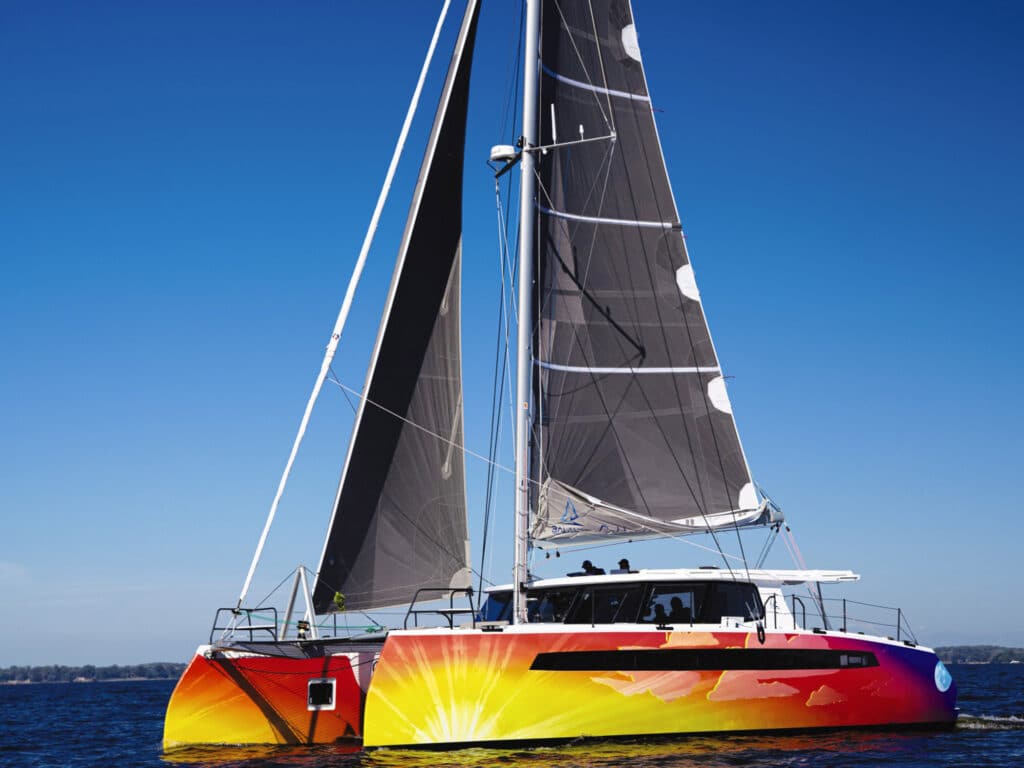
They both love the integration of the cockpit and salon, which allows a greater area to socialize. And they both felt more comfortable with the boat’s systems and performance after some training. “The days of singlehanding a monohull doesn’t prepare you for singlehanding a performance cat,” Hutton says. “Any sailor who has not had modern performance cat experience needs to be humble enough to seek experienced training, especially if your crew is new to sailing.”
Over time, you learn that your boat will need repairs and things will get broken, he says, but you will also enjoy fixing things, eventually. All boats have frustrations; attitude is everything.
“My wife and I have embraced the education and training, and I am glad that I took the ASA Course and hired professional captains to help us learn together. It’s made us a better team, and that extends well past sailing. We’re looking forward to expanding our experiences and capabilities. And we’re hoping to add our dog, Roca, to the crew next year.”
Theresa Nicholson is senior editor of Cruising World. She cruised the Caribbean, South America, South Pacific, Micronesia and Southeast Asia for 11 years on her gaff-rigged Atkin ketch, Tosca.
Monohull Sailors Go Multi
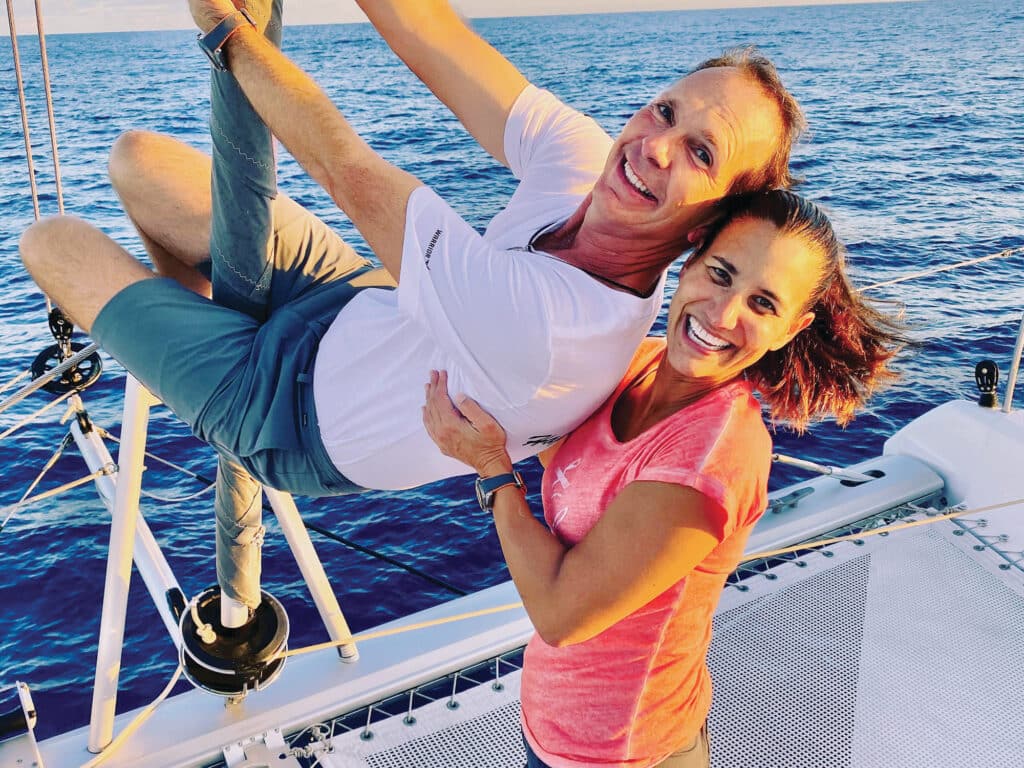
It all started as many sailing stories do: I raced monohulls as a kid in San Francisco with my dad. After Lennie and I married, we stepped away from sailing to raise a family, but we chartered in the Caribbean. After a few trips, Lennie suggested that a catamaran would be a good choice for our three kids. I was horrified and didn’t want any part of it. Eventually I succumbed, and we realized just how great catamarans were for a crowd like us. But whenever Lennie and I charted without the kids, we sailed strictly on monohulls.
When our youngest went to college in 2012, we decided that it was time to buy our own boat. Neither of us even considered a cat. We bought a Hunter 49, which we could sail to weather, with a generator, air conditioner, a washer-dryer and a watermaker—and the added bonus of headroom for me (I’m 6-foot-4). We sailed the Caribbean for three years and loved every minute of it.
A few years into it, several couples who owned large monohulls started telling me they were switching to cats, for the creature comforts and the ease of sailing flat. “Sailing flat?” I asked. “What does that have to do with anything? To sail, you have to bury your rail!”
Eventually, curiosity overtook us, and we did our research and visited Leopard Catamarans in Florida and really liked the forward cockpit. The designer, Simonis Voogd, said that they designed boats to sail and live on comfortably—not the other way around.
We ordered a Leopard 48 and outfitted it in Fort Lauderdale with Just Catamarans. By the time we took delivery, half of the new Leopards were going to private owners instead of into the charter fleets. We sailed that boat 18,000 nautical miles. The leg from the Caribbean to the Panama Canal would have been a rocking-and-rolling mess on our monohull. On our cat? A calm, luxurious trip. We averaged around 7.5 knots under sail and had some thrills at 12 to 14 knots.
After three years, we pulled the trigger on a new Leopard 50. Its design and construction made the boat stiffer between the hull and bridge deck. We took delivery in 2019 and were set to sail to the South Pacific with a rally in 2020, until the pandemic canceled those plans. Instead, we sailed to New England and then throughout the Caribbean again. We had a great time. Our five years of experience sailing catamarans gave us time to consider upgrading to a performance cat.
Today, we have ordered a Kinetic 54, which we think of as the ultimate cat. It’s solid carbon fiber and still full of luxury, another Simonis Voogd creation. When we sail this boat, it feels as comfortable as a typical cruising cat but performs like a speed machine. And tacking into the wind achieves 50 degrees easy, so we can leave the motor off and sail more. Our Kinetic 54 will be delivered in May. We plan to spend a month in Cape Town, South Africa, shaking her down. After that, who knows? We’ve seen every island in the Caribbean thrice, so it’s time to go beyond. -Randy Smith
Randy and Lennie Smith are serial entrepreneurs and commuter cruisers who live and work in South Florida. They’ve been married 25 years and spend the majority of their free time cruising.








